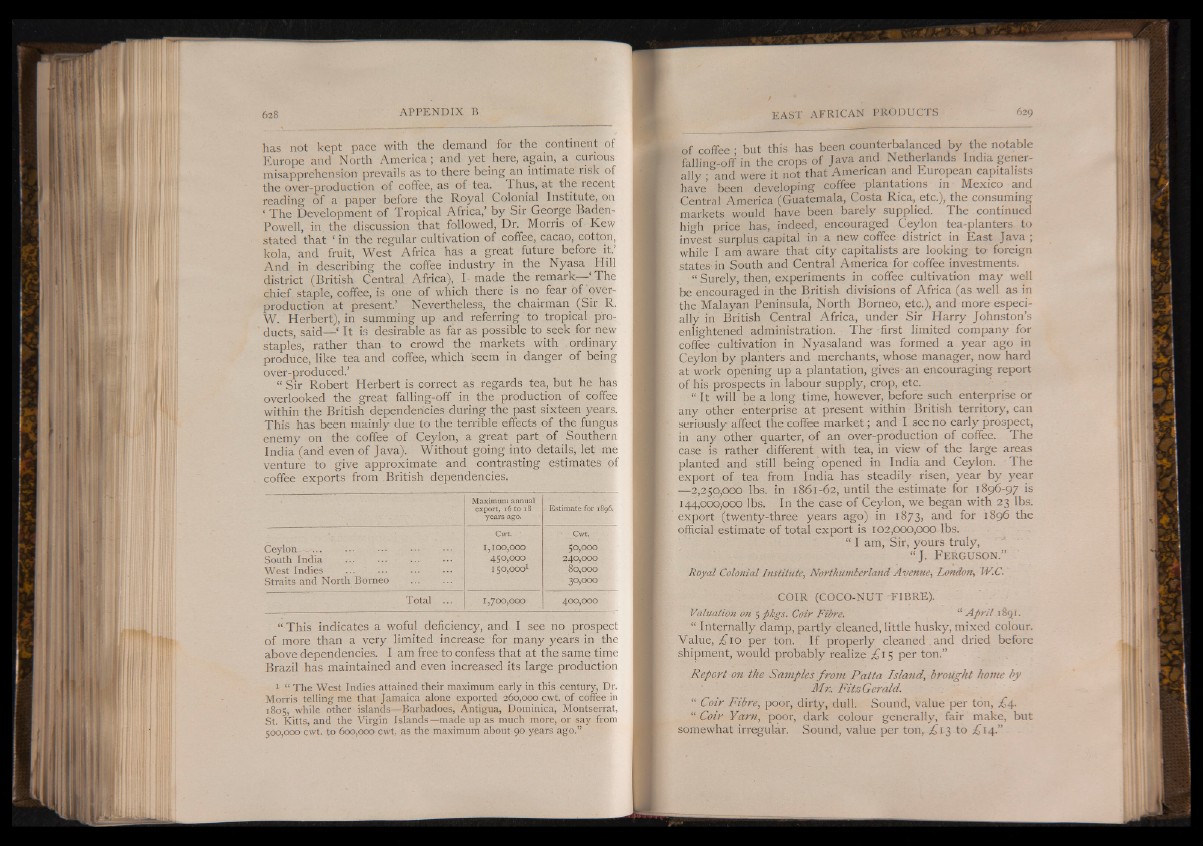
has not kept pace with the demand for the continent of
Europe and North America; and yet here, again, a curious
misapprehension prevails as to there being an intimate risk of
the over-production of coffee, as of tea. Thus, at the recent
reading of a paper before the Royal Colonial Institute, on
‘ The Development of Tropical Africa,’ by Sir George Baden-
Powell, in the discussion that followed, Dr. Morris of-Kew
stated that ‘ in the regular cultivation of coffee, cacao, cotton,
kola, and fruit, West Africa has a great future before it.’
And in describing the coffee industry in the Nyasa Hill
district (British Central Africa), I-made the remark— ‘ The
chief staple, coffee, is one of which there is no fear of overproduction
at present.’ Nevertheless, the chairman (Sir R.
W. Herbert), in summing up and referring to tropical products,
said— ‘ It is desirable as far as possible to seek for new
staples, rather than to crowd the markets with ordinary
produce, like tea and coffee, which seem in danger of being
over-produced.’
“ Sir Robert Herbert is correct as regards tea, but he has
overlooked the great falling-off in the production of coffee
within the British dependencies during the past sixteen years.
This has been mainly due to the terrible effects of the fungus
enemy on the coffee of Ceylon, a great part of Southern
India (and even of Java). Without going into details, let me
venture to give approximate and contrasting estimates pf
coffee exports from British dependencies.
Maximum annual
export, 16 to 18
years ago.
Estimate for 1896.
Cwt. I | Cwt,
Ceylon ...
South India ... ...........................
West Indies ... ... ... ■ - •••
Straits and North Borneo ...............
1,100,000
450,000
15o,ooox
50,000
240,000
80,000
30,000
Total ... 1,700,000 400,000
“ This indicates a woful deficiency, and I see no prospect
of more than a very limited increase for many years in the
above dependencies. I am free to confess that at the samp time
Brazil has maintained and even increased its large production
1 “ The West Indies attained their maximum early in this century, Dr.
Morris telling me that Jamaica alone exported 260,000 cwt. of coffee in
1805, while other islands— Barbadoes, Antigua, Dominica, Montserrat,
St. Kitts, and the Virgin Islands—made up as much more, or say from
500,000 cwt. to 600,000 cwt. as the maximum about 90 years ago.”
of coffee • but this has been counterbalanced by the notable
falling-off in the crops of Java and Netherlands India generally
- and were it not that American and European capitalists
have been developing coffee plantations in Mexico and
Central America (Guatemala, Costa Rica, etc.), the consuming
markets would have been barely supplied. The continued
high price has, indeed, encouraged Ceylon tea-planters to
invest surplus capital in a new coffee district in East Java ;
while I am aware that city capitalists are looking to foreign
states in South and Central America for coffee investments.
I Surely, then, experiments in coffee cultivation may well
be encouraged in the British divisions of Africa (as well as in
the Malayan Peninsula, North Borneo, etc.), and more especially
in British Central Africa, under Sir Harry Johnston’s
enlightened administration. The first limited company for
coffee cultivation in Nyasaland was formed a year ago in
Ceylon by planters and merchants, whose manager, now hard
at work opening up a plantation, gives- an encouraging report
of his prospects in labour supply, crop, etc.
“ It will be a long time, however, before such enterprise or
any other enterprise at present within British territory, can
seriously affect the coffee market; and I see no early prospect,
in any other quarter, of an over-production of coffee. The
case is rather different with tea, in view of the large areas
planted and still being’ opened in India and Ceylon. The
export of tea from India has steadily risen, year by year
— 2,2-50,000 lbs. in 1861-62, until the estimate for 1896-97 is
144,000,000 lbs. In the case of Ceylon, we began with 23 lbs.
export (twenty-three years ago) in 1873, and for 1896 the
official estimate of total export is 102,000,000 lbs.
“ I am, Sir, yours truly,
“ J. F e r g u s o n .”
Royal Colonial Institute, Northumberland. Avenue, London, W.C.
COIR (COCO-NUT FIBRE).
Valuation on 5 pkgs. Coir Fibre. “ A p r il 1891.
“ Internally damp, partly cleaned, little husky, mixed colour.
Value, £10 per ton. I f properly cleaned,and dried before
shipment, would probably realize A15 per ton.”
Report on the Samples from Patta Island, brought home by
Mr.. FitzGerald.
“ Coir Fibre, poor, dirty, dull. Sound, value per ton, £4.
“ Coir Yarn, poor, dark colour generally, fair make, but
somewhat irregular. Sound, value per ton, £13 to A 14.”